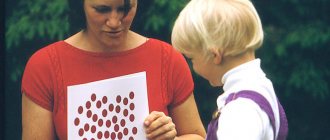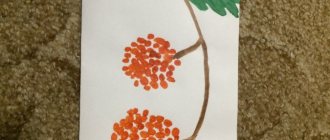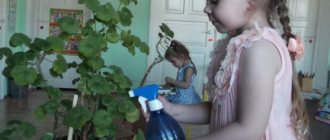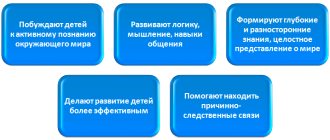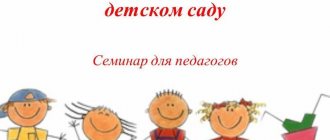The essence of problem-based learning at the preschool educational stage
Definition 1
Problem-based learning technology is a set of teaching methods and techniques that involve the creation of search, problem situations in the educational process, during the solution of which students gain knowledge and master skills.
These technologies find a wide range of applications in the preschool educational process. This promotes the comprehensive development of children of different ages and levels of development. They develop motivation for cognitive work and activate their communication skills. Given that the leading activity of a preschool child is play, problem-based learning technologies are embodied in various types of games.
Are you an expert in this subject area? We invite you to become the author of the Directory Working Conditions
Figure 1. Problem situation. Author24 - online exchange of student work
The essence of problem-based learning, when used in preschool educational institutions, is that, through it:
- A cognitive situation is being formed in the educational process of preschool educational institutions.
- Reliance on previously acquired knowledge and skills of children is implemented.
- A search for information is carried out, and accordingly, skills in operating with various information resources are formed.
- Awareness of the structure of the world and interaction with it is formed on the basis of trust and kindness.
- Children are encouraged to carry out operations of comparison, juxtaposition, and identification of similar and distinctive features of various objects.
- An explanation is provided for those aspects of the world order that cannot be explained in any other way.
Finished works on a similar topic
Course work Technology of problem-based learning for preschoolers in preschool 400 ₽ Abstract Technology of problem-based learning for preschoolers in preschool 260 ₽ Test paper Technology of problem-based learning for preschoolers in preschool 200 ₽
Receive completed work or specialist advice on your educational project Find out the cost
All this reflects the relevance of using problem-based learning at the preschool stage of development and the variability of methods and techniques of problem-based learning included in the educational process of preschool educational institutions.
Figure 2. Features of problem-based learning. Author24 - online exchange of student work
It is known that from birth a child is a discoverer, an explorer of the world that surrounds him. For him, everything comes first: sun and rain, fear and joy. Each answer to a child's question gives rise to new questions. A preschooler cannot yet find answers to all his questions on his own; we, teachers, help him. In our preschool institution, along with the explanatory and illustrative teaching method, methods of problem-based learning technology are used (questions that develop logical thinking, modeling problem situations, experimentation, experimental research activities). The technology of problem-based learning is involvement in games, practical activities, work through the word, works of art, and technical devices. Problem-based learning technologies can be created at all stages of the learning process: during explanation, reinforcement, control. The teacher uses problem situations in conversations on life and health safety, in mathematics classes, familiarization with the outside world, and in play activities.
Problem-based learning is the creation, under the guidance of a teacher, of problem situations and the active work of children to resolve them, as a result of which the creative mastery of knowledge, skills, abilities and the development of thinking abilities occurs. However, this approach is fragmented, episodic in nature: logical tasks are practiced only in separate classes in mathematics, familiarization with the environment, speech development or design tasks. To consolidate acquired knowledge, skills and abilities, we widely use integrated classes, in which, based on the emotional impact on the child, the relationship of one of the sections of the program with others is carried out in a combination of various types of activities. However, the relationship between sections of the program does not provide such effectiveness in the development of children’s cognitive creative abilities and their communication skills as the interpenetration of these sections into each other. An effective means of child cognitive development is the method of problem-based learning technology - the project method. The basis of the project method is: the development of a child’s cognitive skills, the ability to independently construct their knowledge, the ability to navigate the information space, the development of critical and creative thinking, which is what is required in our modern world. The project method develops in children the ability to determine goals and objectives, plan their activities, break into groups, complete the task carefully, to the end, distribute roles within the group, determine the materials necessary for the implementation of the project, and present the result of the work done. Problem situations can be different in the content of the unknown, in the level of problem, in the type of information mismatch, and in other methodological features. Methods of problem-based learning when creating problem situations require active cognitive activity of children, which consists of finding solutions to complex issues that require updating knowledge, analysis, and the ability to see phenomena behind individual facts. Types of problem situations: psychological and pedagogical. A psychological problem situation represents the activities of children. The creation of a psychological problem situation is purely individual. A pedagogical problem situation represents the organization of the educational process, created with the help of activating actions, questions from the teacher, emphasizing the novelty, importance, beauty and other distinctive qualities of the object of knowledge. Problem situations can be created at all stages of the learning process: during explanation, reinforcement, control. The difficulty of managing problem-based learning is that the emergence of a problem situation is an individual act, therefore the teacher is required to use a differentiated and individual approach.
Fundamentals of constructing problem-based learning in the educational process of preschool educational institutions
Problematic situations in the educational process of a preschool educational institution begin with the formulation of a problematic task. The teacher strives to motivate children to learn and act.
The development of a problem situation in a preschool educational institution is based on the following methodological techniques:
- Contradiction. Children need to be shown the presence of one or another contradiction, which they must resolve themselves;
- Variability of solutions. Several options for solving the problem are generated. Children must understand that there may be several possible solutions. In this case, one option is the most optimal;
- Inspiration to action. This technique is based on the motivation to compare, generalize, compare, available data, as well as the logical justification of actions;
- Research techniques. Each problem situation should contain research areas of activity, experimentation techniques;
- Didactic principles. Problem situations are included in the educational process consistently, based on scientific data and the accessibility of their understanding by children of a particular age;
- Location objectivity. The place in which a problematic situation is realized must be relevant for its full, fruitful implementation;
- Originality of situations. Problem situations should be unusual in nature, evoke positive emotions and vivid impressions in children;
- Methods of psychological comfort. It is assumed that the teacher controls the psychological state of children in the course of solving a problem situation, controls the adequacy of situations to the psychological mood of the children, assesses the presence of difficulties in solving problematic problems and provides timely help and support.
Problem situations have different contents. It is determined by the specific age group of children for whose development they are used.
Each problem situation is aimed at developing the child’s creative thinking and activating his creative approach to activities. Children become researchers and learn to apply their knowledge in everyday life.
Consultation for educators “Technology of problem-based learning in kindergarten”
Marina Bogacheva
Consultation for educators “Technology of problem-based learning in kindergarten”
«Problem-based learning technology in kindergarten«.
In life, our children often encounter certain difficulties, but we, adults, protect children from them, not giving them the opportunity to think for themselves, experiment, and, finally, cope with problems .
Why is this happening? Most often due to the lack of our time, due to the possibility of danger in some situations for the child. We consider our children to be insufficiently competent in many issues, unable to understand problems and find a way out of them. Children get used to asking adults for help and hints, and grow up unprepared for the realities of life. But a problematic situation does not always become a problem for the child . We can talk about this phenomenon only if children have shown interest in this problem . It depends on the skill whether children will be interested in new material presented in the form of a problem or not.
The main task of the kindergarten is to fill the daily life of the child in the group with interesting activities, ideas, problems , and to include each child in meaningful activities. The teacher’s goal is to arouse the child’s interest in problematic situations and the desire to creatively solve them.
The emergence of such an innovative trend in preschool pedagogy as problem-based learning is associated with the ideas of the American educator and psychologist John Dewey, who founded an experimental school in Chicago in 1894. The author developed an entire education system, which was later called “ learning by doing ”
.
The basis of education was not the curriculum, but games and work activities.
In Russia, domestic psychologists I. Ya. Lerner, T. V. Kudryavtsev, A. M. Matyushkin, M. I. Makhmutov, M. N. Skatkin were engaged in problem-based learning of problem-based learning is in posing a problem , cognitive task, creating conditions for exploring ways and means of solving it so that the child himself obtains knowledge.
Problem-based learning in kindergarten is an organization of interaction with students that involves the creation, under the guidance of a teacher, of problematic issues , tasks, situations and the active independent activity of children to resolve them.
With problem-based learning, the teacher’s activity changes radically: he does not present children with knowledge and truth in a ready-made form, but teaches them to see and solve new problems and discover new knowledge. What is problem-based learning ?
The essence of problem-based learning in kindergarten is that the teacher creates a cognitive task, situation and provides children with the opportunity to find means of solving it, using previously acquired knowledge and skills. Problem-based learning activates children's thoughts, makes them critical, and teaches them independence in the process of learning.
Each new knowledge reveals to the child little-known aspects of the cognizable object, arouses questions and guesses.
How to organize the cognitive activity of children in order to develop mental processes? (sensations, perception , memory, imagination, thinking, as well as speech development).
In each specific case, the teacher himself decides in what form to work with children: in a group or individually. However, in order to develop children’s ability to doubt and think critically, preference should be given to group forms of work. It is easier for a child to be critical of peers than of adults. A doubt, a guess, an assumption arises when he compares his point of view with the opinion of another person. Communication and joint activities with adults develop the child’s ability to set goals and act, imitating him. And in joint activities with peers, the child begins to use forms of adult behavior, control, evaluate, disagree, and argue. This is how the need arises to coordinate your actions with the actions of your partners and accept their point of view. Therefore, cognitive activity is organized in the form of a dialogue between the child and the teacher and other children in the group. The indicators of such a dialogue are ease of communication and democratic relations.
The formulation of a problem problem and the process of solving it occurs in the joint activity of the teacher and children . The teacher engages the students in a joint mental search and provides them with assistance in the form of instructions, explanations, and questions. Cognitive activity is accompanied by heuristic conversation. The teacher poses questions that encourage children, based on observations and previously acquired knowledge, to compare, contrast individual facts, and then come to conclusions through reasoning. Children freely express their thoughts, doubts, follow the answers of their comrades, agree or argue.
Basic psychological conditions for the successful application of problem-based learning
1. Problem situations must meet the goals of developing a knowledge system.
2. Be accessible to students .
3. Must generate their own cognitive activity and activity.
4. The tasks should be such that the student cannot complete them based on existing knowledge, but sufficient for independent analysis of the problem and finding the unknown.
Why is modern education actively introducing this technology ?
Advantages of problem-based learning :
1. High independence of students ;
2. Formation of cognitive interest or personal motivation of students ;
3. Development of children's thinking abilities.
Flaws
Requires a lot of time to master the same amount of knowledge.
Problem-based learning includes several stages:
1) awareness of the general problem situation ;
2) analysis of the problem situation , formulation of a specific problem ;
3) solving the problem (putting forward, substantiating hypotheses, sequentially testing them)
;
4) checking the correctness of the problem .
Forms of organizing problem-based learning in preschool educational institutions .
There are the following forms of organizing problem-based learning :
— Problematic question
— Problem task
— Problem situation
1) Problematic question : this is not just a reproduction of knowledge that is already familiar to children, but a search for an answer based on reasoning.
“Why do you think in nature you can find both green and yellowish-brown lizards?”
“Why do some puddles on the site dry up quickly, while others do not dry out for a long time?”
That is, the question “When do the leaves fall?”
assumes a specific answer based on knowledge - it's just a question.
To the question “Why do the leaves fall in the fall?”
is
problematic because it requires children to reason when answering it.
Problem questions contain “why?”
,
"For what"
?
For example, which birds of our region are the last to fly south? (just a question)
Why are wild ducks and geese the last to fly south? ( problem question )
.
Why does a duck swim but a chicken doesn't?
Why aren't shoes made of iron?
2) Problem task : The problem task can be divided into two parts. It contains a condition (description)
and have a question?
Examples of problem problems .
Problematic task No. 1.
Pinocchio dropped the key into the water, he needs to get it out, but after jumping into the water, Pinocchio floats up. How can I help him?
Children reason: “Pinocchio is made of wood, but wooden objects do not sink in water.”
,
“A tree is lighter than water, so Buratino cannot dive for the key
.
In the course of reasoning, they demonstrate their knowledge about the properties of wood, and then, due to their creative abilities, come to find an answer to this problematic problem . “You can look for a key at the bottom with a magnet on a string, if the key is metal,” “You can dive to the bottom with scuba gear, like divers do
,” “You can pick up a load, for example, a stone, and then leave it at the bottom and float up.”
Problematic task No. 2.
— One friend lives in the south and has never seen snow. The other lives in the Far North. The snow never melts there.
What can be done so that a friend living in the north sees trees and flowers, and a friend living in the south sees snow and ice. However, they do not want to move.
Problematic task No. 3
— The children made two identical snowmen. One melted within a week, and the other stood until the end of winter.
Why?
3)Problem situation.
A problem situation is the most complex form of problem-based learning .
When solving a problem situation, a state of mental difficulty arises in children, caused by the insufficiency of the knowledge and methods of activity previously acquired by them. It is the problematic situation , according to psychologists, that constitutes the necessary pattern of creative thinking. Contradiction is the main link of a problem situation .
(Contradiction is a situation in which one thing excludes another, incompatible with it, opposite to it.)
Problem situation No. 1 , metal objects sink in water, but a ship built of metal floats. There is a contradiction, uncertainty, why?
In order to solve this problem situation , the teacher organizes a series of experiments with objects, demonstrating that a metal weight placed in water immediately sinks, but the same weight placed on a metal lid does not sink. Why? What keeps it afloat? The teacher prompts the children to find the answer with questions, noting that the lid is filled with air, because there are sides. The higher the sides, the more air there is in the lid, and, consequently, a larger load can be held on it without drowning.
Examining the ship, the children come to the conclusion that its underwater part is hollow and filled with air, so the ship, made of metal, does not sink.
Problem situation No. 2 , the teacher invites children to roll balls made of different materials (wooden, plastic, rubber, glass, metal)
. Children perform actions and see that all the balls roll down and the metal ones stop in the middle of the board.
The unknown in this case is why only the metal ball stopped in the middle of the board.
A contradiction arose: the ball should roll, but it didn’t.
Children think and try to express their assumptions. Those who are not familiar with the properties of a magnet are in difficulty.
Next comes the moment of cognitive activity. Children examine the board to find the reason why the metal balls stop. They show their creative abilities - they suggest something. If someone already has knowledge about the properties of a magnet, they can correctly resolve the contradiction that has arisen without examining the board. Examination of the board and the discovery of a magnet attached to its reverse side completely resolves the contradiction that arose in all children. This introduction to the properties of a magnet will be remembered better than all the stories told by adults, because it is based on emotional perception .
This problematic situation was specially created by the teacher , but very often problematic situations arise naturally. In this case, the teacher is obliged to help children see the contradiction, the inconsistency noticed by one child (or several, and include them in active search activities.
Techniques for creating problem situations when working with preschoolers
— Focusing children’s attention on the contradiction between knowledge and life experience.
— Encouraging children to compare, generalize, draw conclusions, and compare facts by asking heuristic and problematic questions .
— Consideration of any problem from different positions , often role ones.
— Creation of a contradiction, a problematic situation .
— Organization of contradictions in the practical activities of children
Requirements for problem situations :
— the solution to a problem situation should be focused on maximum independence and creative activity of the child;
- the problem must correspond to the educational information that is being learned
the child, as well as the information he already has;
- the formulation of the problem should be as clear as possible and free from
words and expressions that are incomprehensible to children;
- a problematic situation should create sufficient difficulty in solving it and at the same time be feasible for the child. This will create a need to solve it;
- the problem situation should challenge children's curiosity;
- in the process of solving a problem, there should be a need to consider new situations related to it;
- the problem situation should be constructed taking into account the basic didactic
principles of learning ;
— there must be a contradiction at the heart of the problem situation.
Problem-based learning methods :
• Explanatory and illustrative; greater reliance of the presented material on visual forms of interaction;
• Reproductive – repetition of a method of action or element of activity the teacher
• Problem presentation – the presence of a visible contradiction in knowledge and ideas that are already familiar to children;;
• Partially exploratory – teacher- research activities;
• Research method - completely independent research activity of children.
Recommendations for communication style with children
Listen to everyone who wants to. Give only positive ratings. Instead of "right"
It’s better to say
“interesting”
,
“unusual”
,
“curious”
,
“good”
.
During conversations, follow the child’s logic, and do not impose your opinion. Teach your children to object to you and each other, but to object with reason, offering something in return or proving it. If there is a bright leader in the group, over time switch him to some activity and talk with the children without him. In developing children's creative abilities, use active forms of learning - group discussions, brainstorming, role-playing games, group and individual projects, solving situational problems.
EXAMPLES OF SITUATIONAL TASKS FOR THE DEVELOPMENT OF THINKING IN CHILDREN.
• There is a fire in the apartment. What will you do? Why?
• Smoke in the neighboring apartment. Your actions?
• You see someone drowning. What will you do?
• A faucet in the apartment burst. Are you alone at home now. What will you do first, what will you do next? Why?
• Fairy tale “Turnip”
.Grandfather has a bad harvest: the turnip has not grown. How can I help him?
•Mashenka got lost in the forest and doesn’t know how to announce herself and get out of the forest.
• Dunno injured his leg in the forest, but there is no first aid kit. What can be done.
As a result of work to introduce problem-based learning in preschool educational institutions, children become more active, observant and sociable. They themselves “see”
problem situations , formulate contradictions, and find different solutions. Children develop cognitive interest, a desire to explore, experiment, reason and prove
Technological map of activities for problem-based learning of preschoolers
A technological map is an algorithm for solving a problem situation.
It reflects the stages of actions, activities that are implemented by preschoolers and the teacher in the course of solving a problem situation.
The technological map includes the following stages of activity:
- Formulation of the problem. This is the very first and most difficult stage of the work. The teacher needs to explain to the children the essence of the problem, and for the children to comprehend this essence and realize the need to resolve the existing problem.
- Updating knowledge and skills. Children are reminded that they have certain knowledge and skills that will help them solve problems and become the basis of their activities.
- Formulation of hypotheses. At this stage, options for solving the problem are put forward. The teacher assists children in formulating these options.
- Testing hypotheses. Here, various types of children's activities are implemented, in which they check the correctness of the assumptions made. As a rule, different types of games are used, and experimental and research work is also carried out.
- Gaining new knowledge. In the course of activity, new knowledge is formed. The teacher helps children in their approval and introduction to practical activities.
According to this algorithm, learning becomes an independent search for knowledge by children. Children act as discoverers of knowledge.
Problem-search method of teaching preschoolersconsultation
“Problem-search method of teaching preschoolers”
The use of a problem-based teaching method maximizes the activation of children’s speech, thought processes, the search for the correct answer, several answers, and ways to solve the question posed.
Finding solutions to the problem posed by the teacher is the basis of problem-based learning. The more varied and intense the search activity, the more new information the child receives, the faster and more fully he develops.
Problem-based learning is a method organized by the teacher for the child’s active interaction with the problem-based content of learning, during which he becomes familiar with the objective contradictions of knowledge and the way to solve them. Learns to think and creatively absorb knowledge.
The problem-based learning method is based not on the curriculum, but on games and work activities.
The problem-based learning scheme is presented as a sequence of procedures, including:
- the teacher poses a problem task,
- creating a problematic situation for children,
- awareness, acceptance and independent resolution of the problem that has arisen
The first stage of the problem solving process is the search for means of analyzing the conditions of the problem with the updating of previous knowledge and methods of action: “What do we need to remember to solve our question?”, “What can we use from what we know to find the unknown?” This stage is characterized by the confusion of the child, who has exhausted all known ways to solve the problem and has not found the right way. There comes a rejection of known solutions.
At the second stage, the process of solving the problem occurs. It consists in the discovery of new, previously unknown connections and relationships between the elements of the problem, i.e. putting forward hypotheses, searching for “keys”, ideas for solutions. At the second stage of the solution, the child searches “in external conditions”, in various sources of knowledge.
The third stage of solving a problem is proving and testing the hypothesis, implementing the solution found. In practice, this means performing certain operations related to practical activities, performing calculations, and building a system of evidence to justify the decision.
In the process of educational activities using the problem-based learning method, children master various ways of acquiring new knowledge and using these methods to solve specific problems.
The success of such educational activities is a problem situation that is competently created and posed by the teacher.
From a psychological point of view, a problematic situation is a more or less clearly conscious difficulty generated by a discrepancy, inconsistency between the child’s existing knowledge and the knowledge that is necessary to solve the problem that has arisen or proposed.
A task that creates a problematic situation is called a problematic task or simply a problem.
The basis of the problem-based teaching method is the need to stimulate the child’s creative activity and assist him in the process of research activities. Hence the emergence of various ways to solve the problem, the emergence of cognitive interest and, ultimately, the result of all educational activities.
The main psychological conditions for the successful application of the problem-based teaching method are:
· The problem situation must meet the goals of developing a knowledge system.
· Be accessible to trainees.
· Should provoke children’s own independent cognitive activity and activity.
· Tasks should be such that the child cannot complete them based on existing knowledge, but sufficient for independent analysis of the problem and finding the unknown.
The advantages of problem-based learning are:
ü High independence of children,
ü Formation of cognitive interest,
ü Formation of the child’s personal motivation,
ü Development of thought processes in the process of activity in a child.
Thus, the method of problem-based learning involves awareness of the nature of the difficulty due to the insufficiency of existing knowledge, reveals ways to overcome it, consisting in the search for new knowledge, new ways of action, and, as a result, the development of the process of creative thinking.
A problem situation is a situation in which a subject wants to solve problems that are difficult for him, but he lacks data and must look for it himself. A problematic situation arises when a teacher deliberately confronts children’s life ideas (or the level they have achieved) with scientific facts, which they cannot explain - they lack knowledge and life experience.
There are four levels of learning problems:
1. The teacher himself poses the problem (task) and solves it himself with active listening and discussion by the children.
2. The teacher poses a problem, the children independently or under his guidance find a solution. The teacher directs the child to independently search for solutions (partial search method).
3. The child poses a problem, the teacher helps to solve it. The child develops the ability to independently formulate a problem.
4. The child poses the problem himself and solves it himself. The teacher does not even point out the problem: the child must see it on his own, and when he sees it, formulate and explore the possibilities and ways to solve it. (Research method)
As a result, the ability to independently analyze a problem situation and independently find the correct answer is developed.
In one case, the teacher can conduct the search himself with the help of the children. Having posed the problem, the teacher reveals the way to solve it, reasons with the children, makes assumptions, discusses them with the children.
In another case, the role of the teacher may be minimal - he gives children the opportunity to completely independently look for ways to solve problems.
The teaching method associated with children’s independent search and discovery of certain truths is called the problem-heuristic method.
In each specific case, the teacher himself decides in what form to work with children: in a group or individually. However, in order to develop children’s ability to doubt and think critically, preference should be given to group forms of work. It is easier for a child to be critical of peers than of adults. A doubt, a guess, an assumption arises when he compares his point of view with the opinion of another person. Communication and joint activities with adults develop the child’s ability to set goals and act, imitating him. And in joint activities with peers, the child begins to use forms of adult behavior: control, evaluate, disagree, argue. This is how the need arises to coordinate your actions with the actions of your partners and accept their point of view. Therefore, cognitive activity is organized in the form of a dialogue between the child and the teacher and other children in the group. Indicators of such dialogue are ease of communication and democratic relations.
Problem-based learning is the most important means of development for preschoolers. Constantly presenting a child with problematic situations leads to the fact that he does not “give in” to problems, but strives to resolve them, thus we are dealing with a creative person who is always capable of searching. Thus, when entering life, the child will be more protected from stress.
So, the use of problem situations in the educational process helps the teacher to fulfill one of the important tasks set by the kindergarten reform - to form independent, active, creative thinking in students.
Author: Karpova Natalya Igorevna
The essence of problem-based learning in kindergarten.
The essence of problem-based learning in kindergarten is that the teacher creates a cognitive task, situation and provides children with the opportunity to find means of solving it, using previously acquired knowledge and skills. Problem-based learning activates children's thoughts, makes them critical, and teaches them independence in the process of learning. Each new knowledge reveals to the child little-known aspects of the cognizable object, arouses questions and guesses. How to organize the cognitive activity of children in order to develop mental processes? (sensations, perception, memory, imagination, thinking, as well as speech development). In each specific case, you decide for yourself in what form to work with children: in a group or individually. However, in order to develop children’s ability to doubt and think critically, preference should be given to group forms of work. It is easier for a child to be critical of peers than of adults. A doubt, a guess, an assumption arises when he compares his point of view with the opinion of another person. Communication and joint activities with adults develop the child’s ability to set goals and act, imitating him. And in joint activities with peers, the child begins to use adult forms of behavior: control, evaluate, disagree, argue. This is how the need arises to coordinate your actions with the actions of your partners and accept their point of view. Therefore, cognitive activity is organized in the form of a dialogue between the child and the teacher and other children in the group. The indicators of such a dialogue are ease of communication and democratic relations. The formulation of a problem problem and the process of solving it occurs in the joint activity of the teacher and children. The teacher engages the students in a joint mental search and provides them with assistance in the form of instructions, explanations, and questions. Cognitive activity is accompanied by heuristic conversation. The teacher poses questions that encourage children, based on observations and previously acquired knowledge, to compare, juxtapose individual facts, and then come to conclusions through reasoning. Children freely express their thoughts, doubts, follow the answers of their comrades, agree or argue. The basis of problem-based learning is the questions and tasks that are offered to children. Questions are often used that encourage children to make comparisons, to establish similarities and differences. And this is quite natural: a person learns everything in the world through comparison. Thanks to comparison, the child understands the surrounding nature better, identifies new qualities and properties in an object, which makes it possible to take a fresh look at what seemed ordinary and familiar. Questions for comparison are posed in such a way that children sequentially identify first the signs of difference, then the similarities. Among problematic issues, a special place is occupied by those that encourage us to reveal the contradiction between existing experience and newly acquired knowledge. To do this, children must reconsider their previous ideas and rebuild them in a new way. Questions that encourage children to look for an answer in an imaginary way activate their thinking. So, on a summer walk, the teacher asks you to think about how the children’s games would change if it were a frosty winter day? Sometimes you can make a mistake - let the children notice the mistake and correct it. It is important to instill in children an interest in other people's opinions. And don’t forget about a joke: it activates thought and puzzles children. Unexpected entertaining techniques awaken them to think. Especially, such techniques are needed for children with insufficient working capacity (restless): they mobilize their attention and volitional efforts.
Problems of using problem-based learning in the educational process of preschool educational institutions
Despite all the positive aspects of using problem-based learning, its use in preschool educational institutions faces a number of problems. These include:
- Large time costs. Preparing for classes based on problem-based teaching methods requires a lot of time from the teacher. This is due to the age-related characteristics of the development of preschoolers and their receptivity to information, as well as the large expenditure of time on motivation for activity;
- Difficulties in managing the cognitive activity of pupils. The cognitive activity of preschool children is not so easy to control. It is necessary to find the optimal approach to this process;
- The need to activate curiosity. Any problematic situation should challenge the curiosity of preschoolers. Therefore, it is necessary to choose an adequate situation and develop it;
- Correspondence of the problem situation to the topic of training.
Get paid for your student work
Coursework, abstracts or other works
